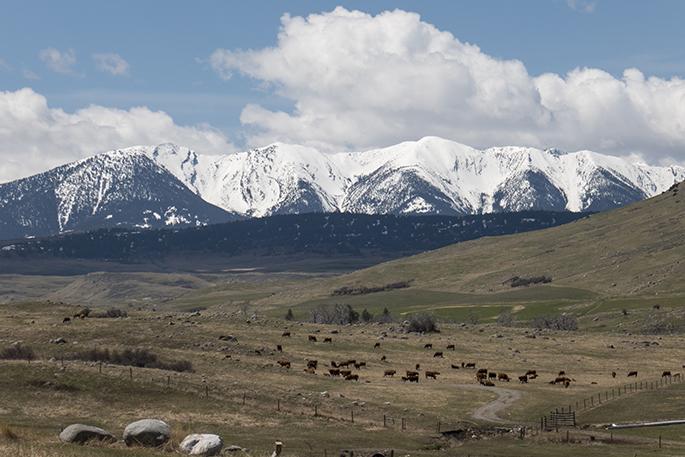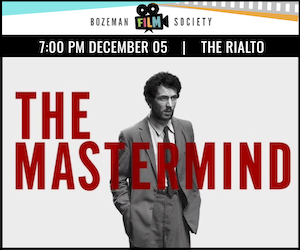Restoring the Whole
Flyfishing within the still clear waters of Ben Hart or Thompson spring creek, you would never realize that you also stood within a cattle ranch that has operated upon the barometric pressure of the rest of the world.
The ranch, owned by the Milesnick family and operated by Tom and Mary Kay Milesnick, has adapted its ranching techniques to roll with the tides of the rest of society. Originally owned by Tom’s grandfather John, who bought the land in 1936, the MZ Bar ranch was purchased by Tom’s parents in 1958. After 30 years in the business, his father retired, and Tom took over the operation in 1988. Since then, Tom has seen the ranching industry evolve from one of instinct to one of science and pasture management.
"I suppose the biggest change in ranching has been within pasture management," says Tom. He smiles and looks to the west over his 1400 acres in the northern portion of the Gallatin Valley. "When the west was settled,” he says, “it was open range." But now, because the land is divided and replete with fences and deeds, ranchers cannot allow a cow to wander 175 miles away to a neighboring county. Ranchers now have to look at innovative ways to graze their cattle, while still preserving what many now call riparian zones.
The Milesnick Ranch has over five miles of the East Gallatin River, plus two notoriously challenging spring creeks, and at any given time, some of the ranch’s 500 head of cattle. Nestled in the center of the Gallatin Valley near Belgrade, the ranch offers a true perspective on "Big Sky Country." Surrounding the ranch are the Bridger, Gallatin, Madison, Little Belt, and Tobacco Root mountain ranges, all capped 300 days of the year in blue sky.
Locals with covetous eyes have looked upon this prime location and Tom and Mary Kay have graciously opened their gates to many. "We have always allowed people to share our resources," says Tom. This included free fishing, whitetail deer hunting, and bird hunting.
However, notes Tom, "with the increased transportation opportunities and the influx of people, and people with more free time, we had to become people managers". At one time the family spent as much time supervising anglers as they did ranching, and so they had to place some limits on the ranch usage.
"We were doing all the managing without getting paid for it,” Tom adds, “and there is no free lunch." Therefore, in 1999, they established Milesnick Recreation and began charging a rod fee to fish the spring creeks. They still allow free fishing on a portion of the East Gallatin; the only request they make is that anglers sign in first. This is so the family can inform anglers of where the cattle are that day. Unfortunately, with that simple request, Tom and Mary Kay still have to shag trespassers from the ranch now and then.
In respect to their generosity, the Milesnicks had to evolve with the growing popularity of destination fishing and a growing valley, but these same factors also affected the methods with which they ranch. The Milesnicks typically run 500 head of cattle, most of which reside in Belgrade from Jan. 1 to May 20. As Tom says, "you can’t afford to add land in this valley, so we had to adopt better management" to accommodate their growing business. Their primary dilemma was how to allow the cattle to feed on limited space without overgrazing any particular section.
What they did was implement a short-duration program that puts the cows on a section for three days at a time, then moves them to an adjacent section. This allows the land and forage to replenish, and the cows constantly have fresh feed. "This short-duration system gives us flexibility. We can either graze our hayfields or hay our pastures."
Not only has this innovative system proved profitable, it has also been nationally recognized. The National Cattlemen’s Beef Association awarded them with the National Environmental Stewardship Award for Region V in Feb. 2001. The short-duration method has produced higher weaning weights in calves and allowed the Milesnicks to concentrate on improving streamside ranching techniques—both of which contributed to the award.
"What we found regarding watering cows, is that if you put a tank near water, they will drink from it for 20 minutes,” Tom says. “But if you allow them to come to a creek as their only source, they will spend 2.5 hours there." He implemented this research in the spring creeks by constructing graveled crossing areas so cattle can pass to more important grazing and watering areas. This keeps the stream banks intact, which benefits the trout, wild mammals, and birds.
All of these actions have shaped Tom and Mary Kay into accomplished and well-respected land stewards. As Tom says, "environmental stewardship is taking care of the land, water, and air, and managing to maintain permanent vegetation." When Tom bought an excavator and decided to restore his creeks, he had that vision in mind.
Now, $60,000 later, the business of fishing is booming. They had over 1300 anglers visit the ranch in 2002, 800 of them free of charge. Their land appears more like a wildlife refuge than a ranch, as mallards, pheasants, herons, pelicans, white tailed deer, and sandhill cranes call it home. The "ranch of many gates" maintains permanent cover for these creatures and the fishery thrives due to graveled cattle crossing areas and the short-duration grazing techniques, from which Tom and Mary Kay have reaped profits and commendations.
Ironically, Tom is not a sportsman, for many reasons. When asked if he gets a day off to play, he laughs and says, "Yeah, from 10 pm to 6 am every day." Obviously, this schedule does not allow time to hunt, but his reasons for not hunting go much deeper. Tom enjoys the wildlife, and with his time constraints and passion for the living animals, he chooses not to carry a gun. His observations of the sandhill cranes have revealed intriguing subtleties. "The ranch is a gathering, or collection area in the fall, and when the jet stream is straight south, the next day they are all gone." He says he checks the Weather Channel, and will call his friends to tell them the 1200 cranes will be gone the next day. He also notices that pelicans have migrated through the ranch more than in the past, but is not sure if the land has become more appealing, or if the pelicans have simply changed their patterns.
Tom and Mary Kay now wear many hats. They have adapted traditional ranching to a world growing in population, recreational opportunities, and environmental awareness. They are cowboys (they ride horses over 200 days per year) and they are fishery managers. But the most valuable quality to all of us and our future, is that they are environmental stewards of the land.






